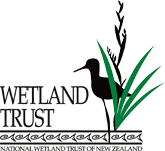Awarua Waituna Lagoon
Other NZ Ramsar sites to visit:
The amazing Awarua peatlands
The Awarua Wetlands can make you feel like a giant striding from coast to mountain in an easy bound.
One minute you can be standing on the glistening, glassy quartz peagravel beach of Toetoe Bay, facing blustery southern oceans and icy polar blasts. Step a few metres away and suddenly you are amidst a rust and green coloured ‘alpine’ meadow in the amazing Awarua peatlands. The winds, cool climate, mists, wet, and low nutrients of the peatland have encouraged hardy alpine plants to make their home on the southern coast over the past 12 thousand years since the last glaciation of the area.
The stunning contrast between the several metre high compacted peat cliffs of the wetland (built up over thousands of years) and the shells, flotsam and jetsam of quartz-graveled Toe Toe Bay is unforgettable.
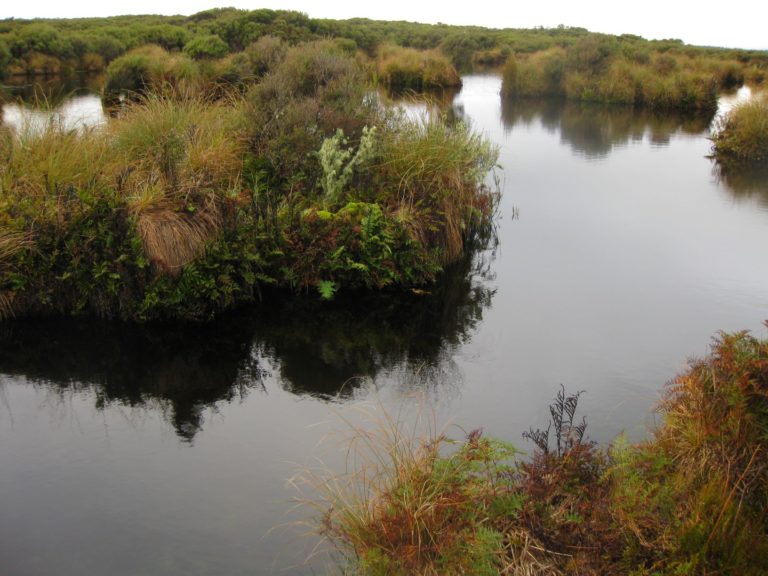
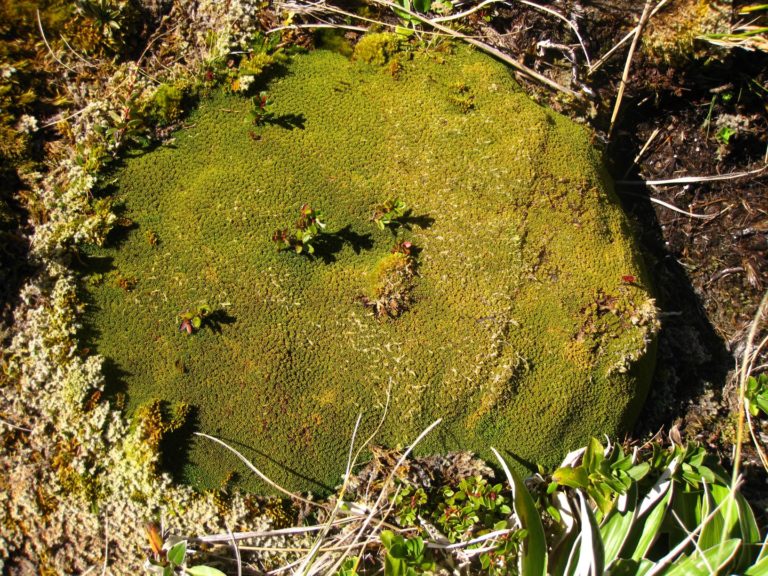
The most startling feature of Awarua’s plant life is its moorlike bog cushion community, formed by low growing plants including Donatia novaezelandiae. From a distance, Donatia resembles a mossy brown boulder, or an elongated cow pat.
But up close it resembles the tightly packed florettes of broccoli. They occur rarely now at Awarua, but there are still several small meadows, amongst the fern fingers of cushionlike comb sedges, surrounded by other alpine species such as bladderwort, sundew, gentian mosses and dwarf manuka.
Some adjoin the tannin stained black tarns creating a stunning alpine bog landscape, right at sea level! In spring and summer it can be ablaze with the yellow, blue, red and lavender coloured flowers of small native lilies, orchid, sundews and other alpine plants. However, the increasing effects of drainage, weeds, and climate change threaten the ecology of this special area.
Waituna Lagoon in the Awarua complex was chosen as New Zealand’s first wetland of international significance (Ramsar site) as its diverse habitats are too tough for other species, making it very special.
There are 80 moth species here with some found nowhere else. The area is also home to native fish such as the giant kokopu, banded kokopu, inanga, eels and lamprey. In 2008, some 15,000 hectares extended the Ramsar site with the addition of three major estuaries: Toes Toes, Awarua Bay and the Invercargill (New River) Estuary. Eighty-one bird species have been recorded at Waituna, including 21 migratory birds that travel north of the equator.
Key facts for visitors
- 18,900 ha reserve complex managed by the Department of Conservation (DoC) consisting of coastal lagoon, peatlands, salt marsh, gravel beach, ponds, estuaries, and lakes.
- Established as Waituna Lagoon Ramsar site (3,500 ha) on 13/08/76 extended in 2008 and renamed Awarua Wetlands. The cushion bog can be seen after walking for several hours from the end of the road along Awarua Bay.
- The Lagoon outlet can be reached after walking for several hours from either the western or eastern entry to the lagoon site. It’s not always open to the sea but is a dramatic feature of the lagoon even when it’s blocked off. Walk along the wild coast and experience the contrast between bog and boisterous waves.
- A 250metre boardwalk winds through lowgrowing manuka and shrubs, emerging at a viewing shelter that overlooks Waituna Lagoon.
- You can explore the margins of the lagoon by kayak or small powerboat, starting from the Waituna Lagoon road end.
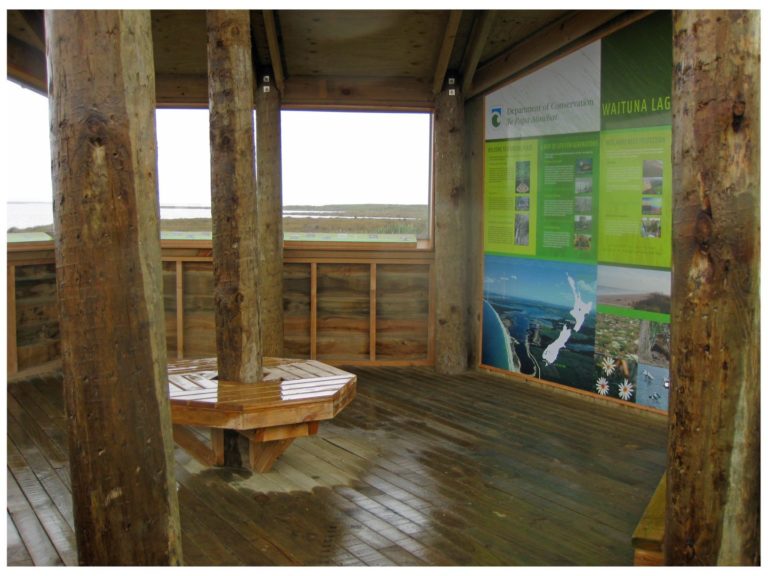
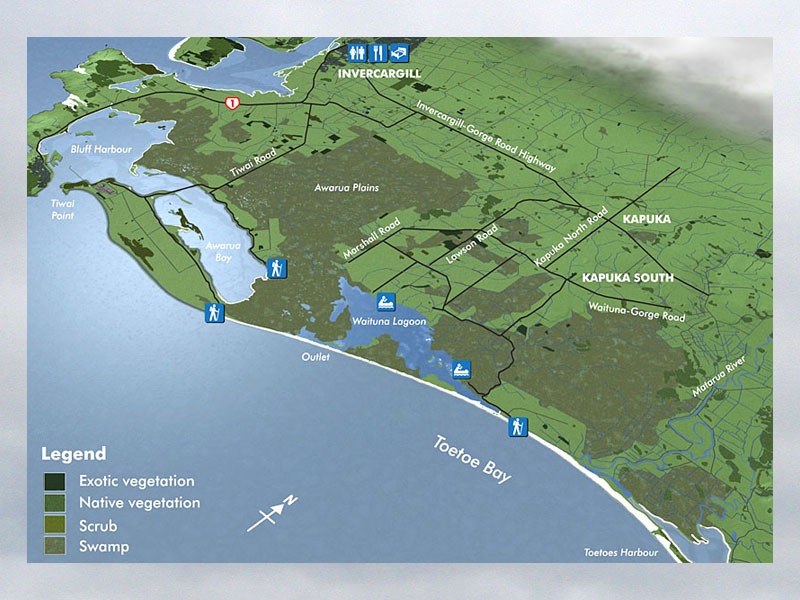
How to get there
It’s well signposted, just follow the signs to Awarua Bay and drive to the end of the road (approx. 15 km from Invercargill).
You can also walk around the head of Awarua Bay across the bog (2.5 hrs) or drive to the end of Waituna Lagoon Road and walk westwards along the coast (1.5 hrs). You can launch a boat at the Waituna Lagoon Road end (approx 25 km from Invercargill).
More information
- See the Waituna website for comprehensive and regularly updated information.
- See this Campbell Live video clip on the threats to the ecological condition of Waituna Lagoon.
- Download the Waituna Lagoon RAMSAR factsheet (144 kb) or read DoC’s factsheet on Awarua Wetland.
- Learn about the DoC’s Arawai Kakariki project to enhance Awarua/Waituna Lagoon.
- Read more about Waituna Lagoon in the Directory of Wetlands in New Zealand (see Chapter 72 Awarua Plains) or in a technical report on its threats and management needs. You can also read a webbook for firsthand accounts of people’s experiences at Waituna from the 1950s to the 1980s.
